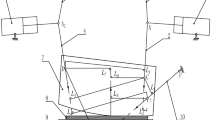Abstract
The dynamic response of a single-rod type EHA (electro-hydrostatic actuator) in the closed-loop control of piston position is inherently dependent on load directions due to the unequal piston areas of the rod-side and head-side. In particular, the response time of the extension and retraction of the piston rod changes significantly when the direction of the external load is changed. In this study, a dual EHA system is proposed, where a force-controlled double-rod type EHA was added to a single-rod type EHA to isolate it from external loads. Force signals for the force control were obtained by measuring the cylinder chamber pressures. The dual EHA system exhibited significantly improved position control performance, even when using basic proportional controllers. An expected collateral benefit is that the system may be reconfigured to a redundant system for fail-safe operation in the emergency case where the main position controlled EHA is malfunctioning.
Similar content being viewed by others
References
Sutton, O., “Super Jumbos: New Systems to Boost Performance, Cut Costs,” Interavia Business and Technology, Vol. 52, pp. 31–33, 1997.
Habibi, S. and Goldenberg, A., “Design of A New High Performance Electrohydraulic Actuator,” Proc. of IEEE/ASME International Conference on Advanced Intelligent Mechatronics, pp. 227–232 1999.
Truong, D. Q. and Ahn, K. K., “Force Control for Press Machines Using an Online Smart Tuning Fuzzy PID Based on a Robust Extended Kalman Filter,” Expert Systems with Applications, Vol. 38, No. 5, pp. 5879–5894, 2011.
Cho, S. H. and Burton, R., “Position Control of High Performance Hydrostatic Actuation System Using a Simple Adaptive Control (SAC) Method,” Mechatronics, Vol. 21, No. 1, pp. 109–115, 2011.
Rahmfeld, R., “Development and Control of Energy Saving Hydraulic Servo Drives for Mobile Systems,” Ph.D. Thesis, Hamburg University of Technology (TUHH), 2002.
Rahmfeld, R. and Ivantysynova, M., “Energy Saving Hydraulic Displacement Controlled Linear Actuators in Industry Applications and Mobile Machine Systems,” Proc. of the 4th International Symposium on Linear Drives for Industry Applications (LDIA03), Birmingham, UK, 2003.
Hewett, A. J., “Hydraulic Circuit Flow Control,” US Patent, 5329767 A, 1994.
Lawrence, P., Salcudean, S., Sepehri, N., Chan, D., Bachmann, S., et al., “Coordinated and Force-Feedback Control of Hydraulic Excavators,” in: Experimental Robotics IV.Lecture Notes in Control and Information Sciences, Khatib O., Salisbury J. K., (eds.), Vol.223, pp. 181–194, 1997.
Wang, L., Book, W. J., and Huggins, J. D., “A Hydraulic Circuit for Single Rod Cylinders,” Journal of Dynamic Systems, Measurement, and Control, Vol. 134, No. 1, Paper No. 011019, 2012.
Pastrakuljic, V., “Design and Modeling of a New Eleciro Hydraulic Actuator,” M.Sc. Thesis, University of Toronto, 1995.
Huang, J., Zhao, H., Quan, L., and Zhang, X., “Development of an Asymmetric Axial Piston Pump for Displacement-Controlled System,” Proceedings of the Institution of Mechanical Engineers, Part C: Journal of Mechanical Engineering Science, Vol. 228, No. 8, pp. 1418–1430, 2014.
Quan, Z., Quan, L., and Zhang, J., “Review of Energy Efficient Direct Pump Controlled Cylinder Electro-Hydraulic Technology,” Renewable and Sustainable Energy Reviews, Vol. 35, pp. 336–346, 2014.
Michel, S. and Weber, J., “Energy-Efficient Electrohydraulic Compact Drives for Low Power Applications,” Proc. of Bath Symposium on Power Transmission & Motion Control, pp. 93–107 2012.
Michel, S. and Weber, J., “Electrohydraulic Compact-Drives for Low Power Applications Considering Energy-Efficiency and High Inertial Loads,” Proc. of 7th FPNI PhD Symposium on Fluid Power, 2012.
Hong, Y.-S., Kim, S.-S., Kim, D.-H., Kim, S.-B., Park, S.-J., and Choi, K.-H., “Design of a Hydraulic Circuit for an Asymmetrically Dualized Electro-Hydrostatic Actuator,” Journal of The Society for Aerospace System Engineering, Vol. 8, No. 2, pp. 7–13, 2014.
Fu, Y., Pang, Y., Liu, H., and Zhang, Y., “Force Fighting Research of Dual Redundant Hydraulic Actuation System,” Proc. of International Conference on Intelligent System Design and Engineering Application (ISDEA), pp. 762–766 2010.
Shi, C., Wang, X., Wang, S., Wang, J., and Tomovic, M. M., “Adaptive Decoupling Synchronous Control of Dissimilar Redundant Actuation System for Large Civil Aircraft,” Aerospace Science and Technology, Vol. 47, pp. 114–124, 2015.
Lee, S. R. and Hong, Y. S., “Synchronous Control of an Asymmetrical Dual Redundant EHA,” Journal of Drive and Control, Vol. 13, No. 2, pp. 1–9, 2016.
Lee, S. R. and Hong, Y. S., “Control-Performance Improvement of Dual EHAs,” Journal of Drive and Control, Vol. 13, No. 3, pp. 32–38, 2016.
Alleyne, A., Liu, R., and Wright, H., “On the Limitations of Force Tracking Control for Hydraulic Active Suspensions,” Proc. of American Control Conference, pp. 43–47 1998.
Alleyne, A. and Liu, R., “A Simplified Approach to Force Control for Electro-Hydraulic Systems,” Control Engineering Practice, Vol. 8, No. 12, pp. 1347–1356, 2000.
Boaventura, T., Focchi, M., Frigerio, M., Buchli, J., Semini, C., et al., “On the Role of Load Motion Compensation in High-Performance Force Control,” Proc. of IEEE/RSJ International Conference on Intelligent Robots and Systems (IROS), pp. 4066–4071 2012.
Habibi, S., Burton, R., and Sampson, E., “High Precision Hydrostatic Actuation Systems for Micro-and Nano-Manipulation of Heavy Loads,” Journal of Dynamic Systems, Measurement, and Control, Vol. 128, No. 4, pp. 778–787, 2006.
Cho, S. H. and Helduser, S., “Robust motion Control of a Clamp-Cylinder for Energy-Saving Injection Moulding Machines,” Journal of Mechanical Science and Technology, Vol. 22, No. 12, pp. 2445–2453, 2008.
Author information
Authors and Affiliations
Corresponding author
Rights and permissions
About this article
Cite this article
Lee, SR., Hong, YS. A dual EHA system for the improvement of position control performance via active load compensation. Int. J. Precis. Eng. Manuf. 18, 937–944 (2017). https://doi.org/10.1007/s12541-017-0111-7
Received:
Accepted:
Published:
Issue Date:
DOI: https://doi.org/10.1007/s12541-017-0111-7




